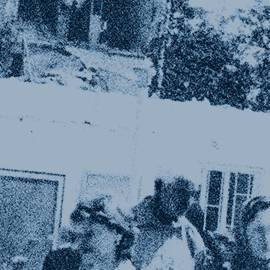Pillage
We have already described the practice of destroying private property during the conflict in the North Caucasus, applied as one of the means of terror against civilian populations.[1] This publication will discuss another human rights violation related to the private property of citizens.
Pursuant to Article 17 of the Universal Declaration of Human Rights:[2]
i. Everyone has the right to own property alone as well as in association with others.
ii. No one shall be arbitrarily deprived of his property.
Article 4(2)(g) of Additional Protocol II to the Geneva Conventions relating to the Protection of Victims of Non-International Armed Conflicts prohibits the pillaging of the civilian population as an instrument of war.[3] Unfortunately, the statistics of the Natalia Estemirova Documentation Center Database (hereinafter the Database) reveal that pillaging was a common practice exercised during the conflict in the region and, in most cases, carried a mercenary motive. In addition, being in possession of property could have served as a reason for the commission of a number of other violations against a victim. Those who had been deprived of their property were placed in difficult situations during the course of the conflict and, as a result, joined the large-scale rows of internally displaced persons.
The Database contains data on the victims whose right to property was violated during the conflict in the Chechen Republic. Encompassed within this are the crimes of robbery/extortion and other accompanying violations such as murder, kidnapping, enforced disappearance, torture, etc. The collection of data relating to victims who have not suffered accompanying violations is still ongoing. Accordingly, this publication is divided into three parts and gives the most complete picture of the incidents that took place in Chechnya.
The first part covers the victims registered in the Catalogues of the Database; this section also provides a description of accompanying violations.
The second part introduces the preliminary statistics and accounts of people who have not yet been fully verified in the Database. This is necessary in order to understand the scale and specificities of the violations against all of the victims registered in the Database.
The third part of the publication provides statistical and descriptive information regarding the property of the victims. This enables readers to identify the various categories of classified objects, and also to assess the extent of the damage caused.
Violation of the right to property among the verified victims
If a victim is registered in the Catalogues of the Database this means that the information provided about them has been verified through different information donors. Accordingly, the relevant information concerning them is considered to be the most complete and reliable available. It should be noted that in addition to those situations where the victim was robbed, the Database also contains information concerning the extortion of property from the population. Thus, at least 1,396 people are registered in the Catalogues of the Database as victims of the violation of the right to property during the conflict in the North Caucasus.[4] 1,174 victims of the total number suffered directly within the territory of the Chechen Republic. Chart 1 shows the disaggreggation of victims by gender. As can be seen, the overwhelming majority of the victims – 1,047 individuals – were male, and the remaining 127 female.
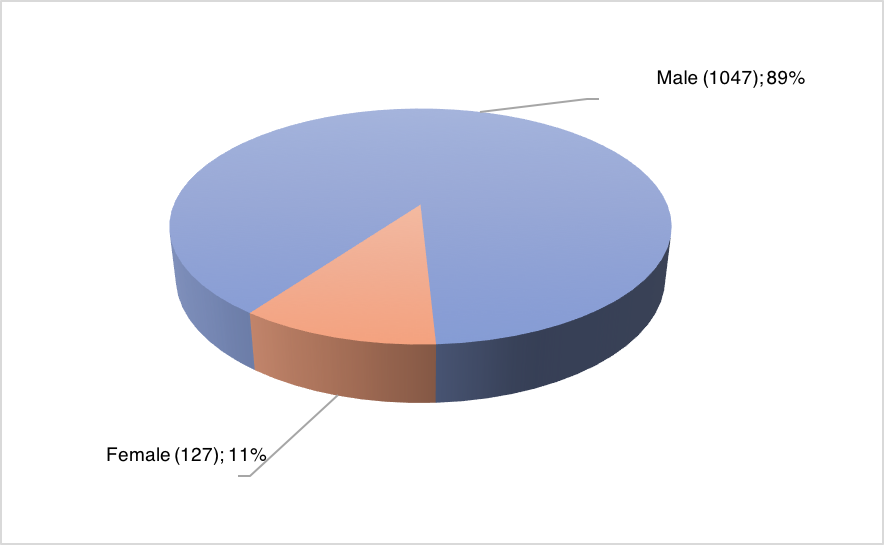
The statistics within the Database reveal that the civilian population was significantly affected by these crimes; 853 of the registered victims were civilians.[5] In 94% of cases of violations against the civilian population, the involvement of Russian military personnel, or forces working in the interests of the military personnel, was established. In some cases, civilians who had their property stolen were also attacked by fighters, however, only four such cases are registered in the Database, which constitute less than 1% of the overall number of incidents. In the remaining 5% of registered cases against civilians, the responsible party could not be identified.
As was the case relating to other violations, incidents which involved lootings, thefts, robberies and extortions mainly took place in the context of large-scale or separate special operations and sweeping operations (zachistkas). The statistics from the Database confirm that at least 599 victims suffered violations under such circumstances. This number is slightly above half of the total number of victims in the Chechen Republic. According to eyewitnesses, the actions of the military personnel varied on a case-by-case basis.
Based on the total number of victims, almost every third violation in Chechnya occurred during attacks on the territory of the victim’s house. At least 56 cases were committed when the victim was on the road. In some cases, owners were able to notice right away following searches and inspections that their property had disappeared, while in other instances property was plundered in front of the victims, committed in a blatant and undisguised manner.
For example, on the evening of 5 February 2001, on the outskirts of the Tevzana village in the Vedensky District, the military broke into the houses of the miller brothers’ families. They removed the men and women, who were barefooted and barely dressed, from the house and forced them to lay outside on the snow whilst repeatedly beating them with their guns. It was only later that night that the residents were allowed to return to their houses with their children. During the entire incident, the military personnel drank vodka and ate food belonging to the owners of the house. The house itself was completely damaged by the military personnel: furniture and utensils had been damaged by machine guns, and carpets and blankets had been cut with knives. While leaving, the military stole remaining food stocks and items that they considered to be valuable. According to one of the victims:
They were harassing us until the one who came first calmed down. Until he went to sleep at 4 a.m., we all were being harassed. And after he went to bed – it became quiet … Now my daughter´s gold chain went missing, we can’t find a hat, the food from the pantry was taken away.[6]
As stated previously and described in the case above, victims registered in the Catalogues were often subjected to other violations during the conflict as well. Chart 2[7] presents the most common accompanying violations committed during the looting of property. As shown in the chart, one of the most common was the violation of the right to liberty and security of the person. This indicates that the property of the victims was often stolen during the legal or illegal detention of the victim, as well as during kidnappings. Another widespread offense was the violation of the right to life. Available statistics indicate shocking results: in approximately one third of the cases the victim was either killed or disappeared. In the cases of 24 victims, their murders occurred in extremely cruel circumstances. One such inhuman account is provided in the Database. On the night of 6 October 2002 in Grozny, armed and camouflaged men arrived in an armored carrier Ural vehicle and entered the house of one of the local residents. A few hours later, the neighbors heard a scream, however they did not dare enter the victim’s house until the morning, at which point they found the headless corpse of the owner of the house. The victim had signs of torture on their body and the whole room in which the body had been found was splattered with blood. According to eyewitnesses, the house had also been robbed and even the furniture had been taken away. Bedlinens were thrown in the courtyard and on the street and open jars of canned meat, fried potatoes and other food items were found on the table.[8]
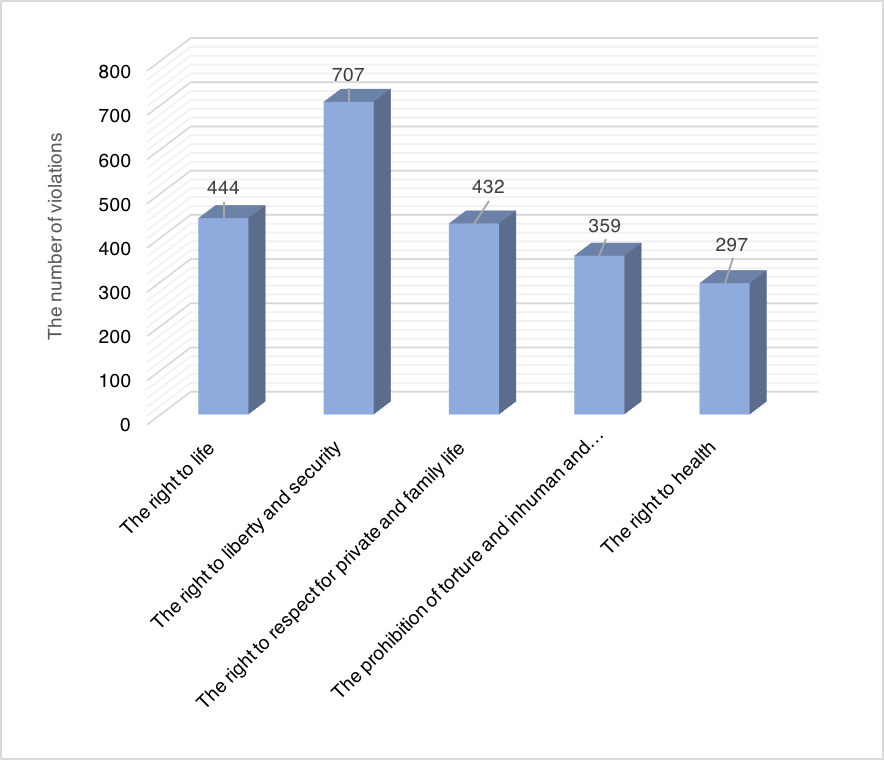
The narratives of the cases mentioned gives the ground to conclude that looting of property was essentially a “legalized” well accepted method of obtaining profit during the conflict in Chechnya. The stories of verified victims in the Database present a grim picture of the hopelessness and deprivation of the civilian population to protect their fundamental rights, such as the right to life, but also the right to property.
Infringement of the right to property with regard to unverified number of victims
In addition to the victims verified through the Catalogue, the Database also contains data concerning victims whose right to property was also infringed but who are yet undergoing the verification process within the Database. Thus, there are still at least 1,364 unprocessed profiles of victims in the Chechen Republic whose property was either stolen or extorted.
It should be emphasized that a number of similarities exist between the violations committed against verified victims included in the Catalogues of the Database and unverified victims. For instance, as in the case of verified profiles, the majority of violations against unverified victims – 1,105 cases – were directed against the civilian population by Russian military personnel or forces acting in their interests. Some of the victim profiles in the Database, both collective and individual, do not include the names of the victims (nameless profiles) as this information could not be determined and is impossible to ascertain. As a result, such victims will most likely not be included in the final Catalogue of the Database, however, these profiles are nevertheless significant in order to assess the extent of the damages suffered by the population at large during the conflict.
Among the unverified profiles that have not been yet counted, at least a quarter – or 299 people – belonged to vulnerable groups such as children, the elderly, pregnant women, the disabled, those in a helpless state and others. Thus, individuals that were recipients of such arbitrary treatment were not exempt on grounds of their age, social status or health. For example, on 10 July 2002, a federal troop had settled in the south-eastern outskirts of the village of Kurchaloy and had been shelling the surroundings of the village until the morning, after which it headed to the village of Belorechye. On the night of 11 July, the soldiers from the troop broke into the house of a 60-year-old man. They turned everything upside down, and stole video equipment and other valuables, including money such as the old man’s savings that he had worked his entire life as a school teacher to accumulate.[9]
In another case, one of the victims of the attack was a five-month pregnant woman. In the early morning of 27 August 2002 in the city of Gudermes, a young man was kidnapped from his house by unidentified masked and camouflaged armed forces. His pregnant wife had her head covered, and arms and legs tied with bedsheets and was beaten with machine guns. She describes the situation as follows:
When leaving, the military ordered me not to move and keep quiet. In the house everything went silent, but after a while someone entered the room and untied my legs. Soon, I felt an unpleasant smell and realized that it was gas. Pulling the sheet off my head, I left the house and asked for help.[10]
Later it became clear that the unknown military personnel had taken all documents relating to the family with them, including passports, employment records, and a book declaring household ownership. Given that a lack of authentic documents were often one of the main causes of violations against the population, such theft carried much more serious consequences for survivors of the attack.
Accordingly, the analysis of yet unverified victims registered in the Database gives the possibility of establishing additional details on the violation of the right to property in the context of the conflict in the Chechen Republic and expands the scale of the committed crimes.
Classification of the damage caused to protected property
The functionalities of the Database are not limited to the analysis of victim profiles only. Among other things, damaged protected property has been separately registered in the Database, and categorized according to its typology, the degree of damage caused, the status of the affected persons etc. These entries have been checked and though attempts have been made to verify the data, the actual verification process is planned for the future. Nevertheless, at its current stage, the Database still enables the creation of a complete overview of the type of property, the means and other details of the damage caused by intruders during the conflict. Accordingly, the Natalia Estemirova Documentation Center is in possession of the complete data relating to over 2,004 property objects stolen or extorted from victims during the conflict in the Chechen Republic. The majority of these, or 1,197 items, constitute money and personal belongings of victims (for example, clothes, watches, household items etc.). An additional approximately 300 objects were stolen and documents of victims were forcibly taken. As mentioned above, the deprivation of documents had particularly serious consequences for the victims in the future.
Ransoms and bribes paid are placed in a special category in the Database, with approximately 166 such objects registered. The payment of a ransom could ensure the life or freedom of the victim or victim´s relatives, the return of the body of a murdered person, or information about the location of their burial. People were buying their ways out of torture, rape, beatings and abductions. At roadblocks payments were given for the possibility of escaping combat areas. In most cases, ransoms were paid in money and often requested in foreign currency. However, extortionists were not limited to monetary rewards: payments of ransoms in the form of cars, equipment, alcohol, livestock, jewelry, food and other household items were also recorded. For example, in mid-January 2002, a sweeping operation accompanied by mass violations took place in the village of Bachi-Yurt. Many of the local residents were arrested illegally and taken to a so-called “filtration point” where they were beaten, tortured and treated inhumanly. Several people were killed in and around the village. In addition to this, money was extorted on a massive scale. This is how one of the victims described the situation:
The military wanted to take the son, but I gave them 300 rubles, and they were done with him. They visited me at three in the morning. They demanded that I turn on the TV. Then they forced me to make food and tea for them. The military took everything from my neighbors, loaded them into the car, broke the windows and drove away. They took away carpets from people, everything that was valuable in the house.[11]
According to eyewitnesses, the amount of ransom for victims´ freedom or the freedom of their relatives was different in various parts of the village, however, on average, it amounted to approximately 1,000 rubles.
In another incident on 20 April 2001, residents of the village of Alkhan-Yurt, including students and teachers from the local school, were attacked by the military. Residents were detained publicly on the streets, and detainees were subjected to beatings, torture and inhuman treatment. In addition, private and commercial property of villagers was stolen or destroyed. According to one of the witnesses:
Money and medicines were taken from the pharmacy. They ripped golden earrings off from the girl´s ears, robbed the market, and then destroyed it. BTR drove over potatoes and other products. They took the money from the cafe, arcades, the motor, games. Leaving, they shouted: “We will be back”.[12]
Reviewing the available statistics, it is possible to draw conclusions about the scale and specificity of the violations described. The information presented in this publication tells only a small part of the circumstances under which the right to property of the population was violated. The Natalia Estemirova Documentation Center Database contains hundreds of stories of people who were deprived of their property and left without a livelihood, in the difficult conditions of war. While some victims managed to find ways out of the situation with the help of relatives and acquaintances or sought refuge in other regions of the country, for most other victims, infringement upon their property was only one link in the endless chain of other crimes committed during the conflict in the Chechen Republic.
The statistics provided were updated on 17 March 2019.
The data is subject to change in view of the ongoing work by the Natalia Estemirova Documentation Center on the search and identification of victims of the armed conflict.
Audio library
Listen to the story of a refugee from Alkhan-Kala concerning the “sweeping operation” in the village.
For details on this story, see the “Audio” section.
Listen to the story of a woman who survived the storming of the city of Grozny.
For details on this story, see the “Audio” section.
Media library
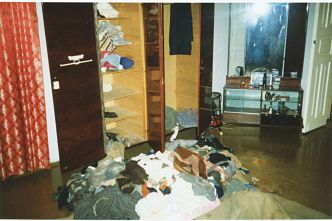
NEDC document 33907 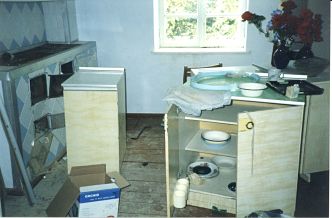
NEDC document 33908 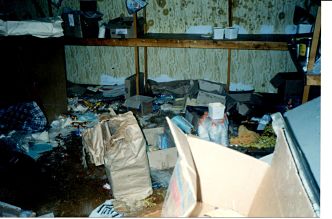
NEDC document 33910 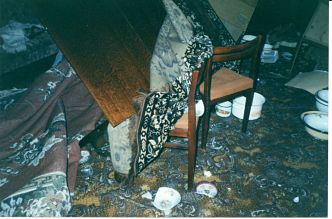
NEDC document 33909 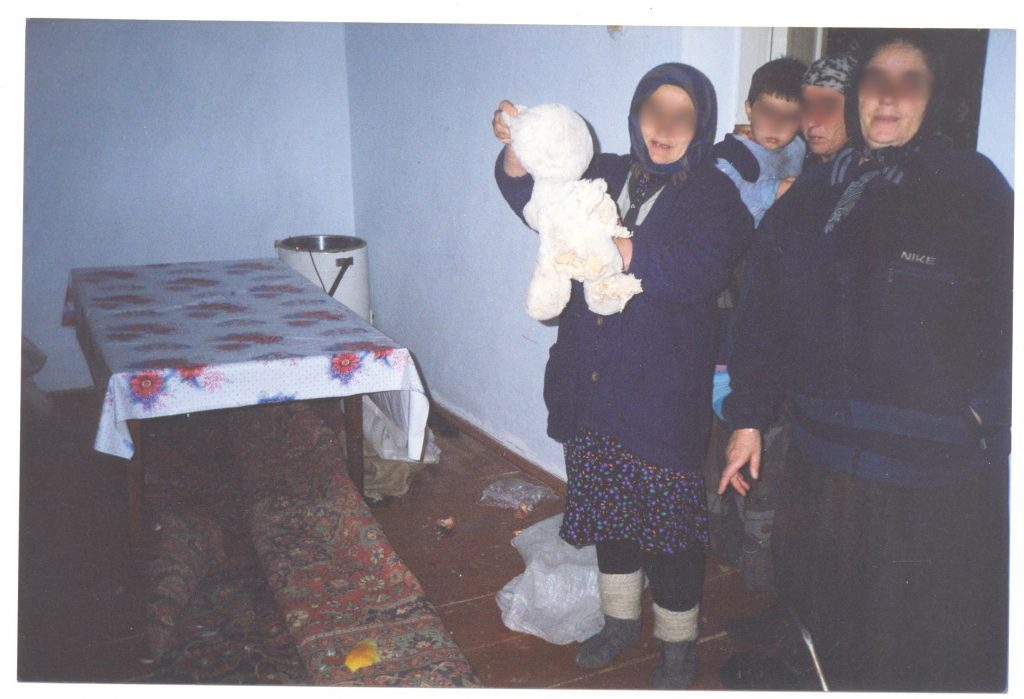
NEDC document 32106 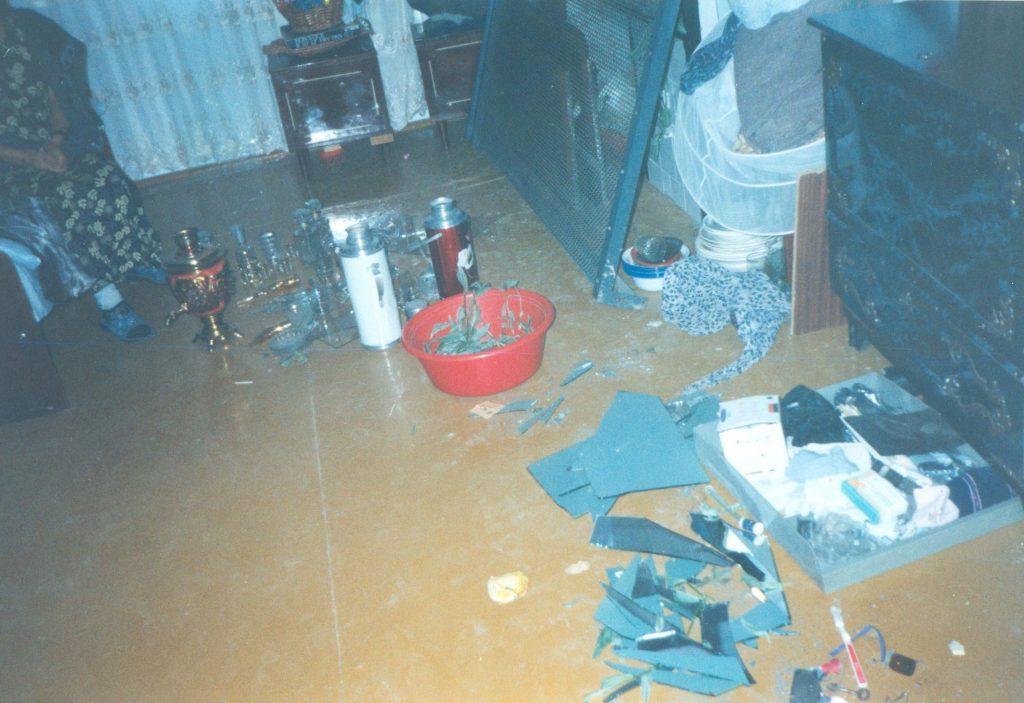
NEDC document 32103
References
[1]See publication «Destruction of property of civilians» on this website.
[2]UN General Assembly, Universal Declaration of Human Rights, 10 December 1948, 217 A (III)7.
[3]Additional Protocol II to the Geneva Conventions of 12 August 1949, Concerning the Protection of Victims of Non-International Armed Conflicts (Art. 4(2)(g)).
[4]The Database contains information mainly about violations committed during the second armed conflict that started in 1999. However, there is also sporadic information about the incidents that took place during the first armed conflict.
[5]The Natalia Estemirova Documentation Center Project uses the definitions of civilian population and combatants/irregular fighters depending on the degree of involvement of the population in hostilities, based in the context of the non-international armed conflict in Chechnya.
[6]Incident № 672 «Attack on the families of two brothers from the village of Tevzana, February 5, 2001».
[7]Some of the victims could be subjected to several violations at the same time or for a period of time. The graph shows the most common violations against victims.
[8]Incident № 3178 «Abduction and Murder in Grozny, September-October 2002».
[9]Incident № 3178 «Kidnapping of a person and subsequent zachistka in the village of Kurchaloy, July 2002».
[10]Incident № 3290 «The disappearance of two men in the city of Gudermes, August 2002».
[11]Incident № 368 «Zachistka in Bachi-Yurt, January 2002».
[12]Incident № 585 «Detention of people and an attack on a school in Alkhan-Yurt, April 20, 2001».
